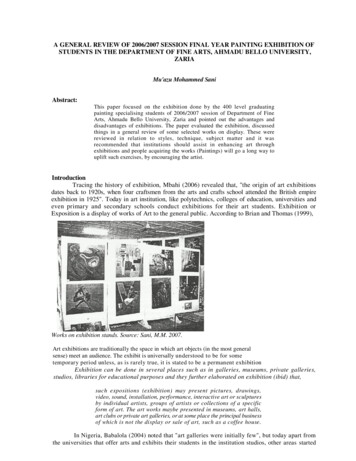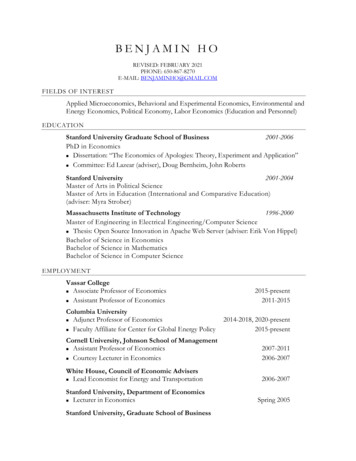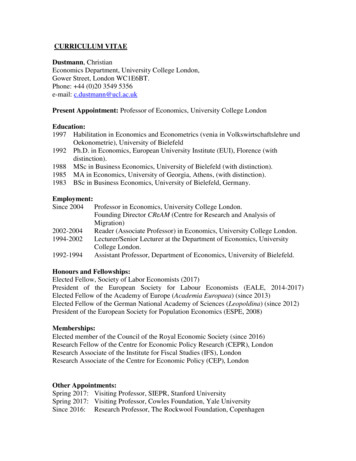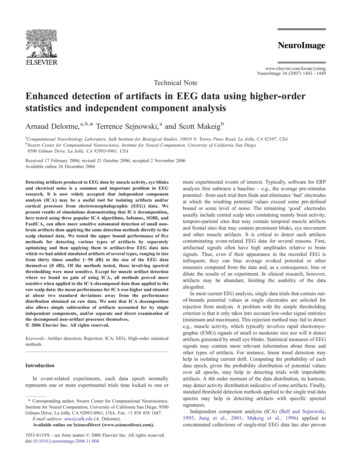
Transcription
A GENERAL REVIEW OF 2006/2007 SESSION FINAL YEAR PAINTING EXHIBITION OFSTUDENTS IN THE DEPARTMENT OF FINE ARTS, AHMADU BELLO UNIVERSITY,ZARIAMu'azu Mohammed SaniAbstract:This paper focused on the exhibition done by the 400 level graduatingpainting specialising students of 2006/2007 session of Department of FineArts, Ahmadu Bello University, Zaria and pointed out the advantages anddisadvantages of exhibitions. The paper evaluated the exhibition, discussedthings in a general review of some selected works on display. These werereviewed in relation to styles, technique, subject matter and it wasrecommended that institutions should assist in enhancing art throughexhibitions and people acquiring the works (Paintings) will go a long way touplift such exercises, by encouraging the artist.IntroductionTracing the history of exhibition, Mbahi (2006) revealed that, "the origin of art exhibitionsdates back to 1920s, when four craftsmen from the arts and crafts school attended the British empireexhibition in 1925". Today in art institution, like polytechnics, colleges of education, universities andeven primary and secondary schools conduct exhibitions for their art students. Exhibition orExposition is a display of works of Art to the general public. According to Brian and Thomas (1999),Works on exhibition stands. Source: Sani, M.M. 2007.Art exhibitions are traditionally the space in which art objects (in the most generalsense) meet an audience. The exhibit is universally understood to be for sometemporary period unless, as is rarely true, it is stated to be a permanent exhibitionExhibition can be done in several places such as in galleries, museums, private galleries,studios, libraries for educational purposes and they further elaborated on exhibition (ibid) that,such expositions (exhibition) may present pictures, drawings,video, sound, installation, performance, interactive art or sculpturesby individual artists, groups of artists or collections of a specificform of art. The art works maybe presented in museums, art halls,art clubs or private art galleries, or at some place the principal businessof which is not the display or sale of art, such as a coffee house.In Nigeria, Babalola (2004) noted that "art galleries were initially few", but today apart fromthe universities that offer arts and exhibits their students in the institution studios, other areas started
allocating spaces for art shows like the art expo Las Vegas, an annual international exhibition. Nowdue to advancement, exhibitions are been held in various places, some could be the traditional placesexhibitions holds and different types with different purposes, as illustrated by Anati (1981),There are different kinds of art exhibitions, for example retrospectives,which look back over the work of a single artist, individual expositions,group expositions or expositions on a specific theme or topic. Travellingexhibition is another category of art exhibitions"Assessment exhibition like that of the final year student of Fine Arts Department, AhmaduBello University, Zaria is another type of exposition, that it is a very important aspect for an artistwho is about to be a professional. Foreign cultural centres, like Italian Cultural centre, Goethe Institutof Germany, British Council and Alliance Fran9oise, a French Cultural centre in Kaduna, according toAgada (2004) thus,"organises and holds exhibitions at its gallery, works of youngtalented Nigerian artists especially from Zaria Art School,Ahmadu Bello University, Zaria. The centre has done a lot inthe development, encouragement and sponsorship of artists whoexhibit in the gallery.Therefore, this paper discussed exhibition in general, its advantages and the disadvantages, italso reviewed the exposition in general, with some selected works done by exhibiting students,summary, conclusion and recommendations are inclusive.Advantages and Disadvantages of ExhibitionExhibition is indeed a very important event in artistic circle, whether it is encouraging or not, noartist known today without exhibiting for people to see his or her creative works so that he can berecognised as an artist. Advantages of exhibition are overwhelming, whether in academic circle ornot, therefore exhibition:a.helps in educating individuals and the general public,b.c.d.helps in exposing the students and trains the students to sell and exhibit their work of Arts.creates job opportunities for the artists.teaches the artists how to exhibit his or her works (Paintings) after graduation.e.in education circle, it helps the teacher to assess the ability of his students.f.And Agada (2004) slates that exhibition "encourage research works or activities on art in thecountry.It is noted that sometimes exhibition is an avenue that mar artists and this problem could beas a results of:a.b.c.d.e.Lack of publicity or awareness.Not enough room for carrying or displaying art works and also the location.No sales when the purpose was to achieve that.Exposes student's negative ability in academic exercise.Bad comments on the works.A Review of Exhibition in GeneralExhibition is traditionally a space in which art objects (in the most general sense) meet anaudience. It is also a display of works of Arts to the general public and such exhibitions containsexpositions which may present pictures, drawings, video, sound, installations, interactiveperformances, art or sculpture by individual artists, groups of artists or collections of a specific
Visitors at an academic exhibition. Source: Sani, M.M. 2008Form of art. Exhibitions can be done in museums for example; National Gallery Abujaconduct exhibitions, art halls, art clubs or private art galleries etc. Types of exhibitions include soloexpositions, group expositions on specific themes or topics. This exhibition is no other exhibitionbeyond the usual type, it is an academic exhibition that was assessed arid was opened for the public tosee the product of the graduating students. Best (1985) in Mbahi (2005) believed that "to assess andconsider creativity we have to concentrate on the product (Art work)" before we can see, review,critique and award marks as it is tenable in the final exhibition. General review was discussed basedon these points; i) styles, ii) techniques and iii) subject matter.i) StylesLooking at the exhibited works one will agree with Akudu (2001) in his general observationof Nigerian Artists that,One other major influence on the work of art in Nigeria today isWestern influence. Since the colonial period, artistically talentedpeople have been attracted into the European educational systemand they have directed their talents along European lines.Contemporary Nigerian artists have been trained along thewestern orientation and many of them see the traditional art oftheir own society from the angle of European culture ratherthan from their own culture.This greatly affects the young upcoming artists that European influences affect the style, forexample, some Nigerian artists will like their brush strokes to look like Rembrandt or paint Mona Lisain African skin. Nigerian may not have an independent style that will be considered individualistic.Anyway, several colours on the exhibited works suggested the Zaria art school style.ii) TechniquesThe techniques employed in their works are primarily vibrant brush strokes. As it wasgenerally observed, each student struggled to see himself different from his class mates in terms oftechnique; this is as a result of the leverage given to them so that they can explore every techniquewith the hope to discover a unique way of expression. On like Nsukka with their Uli art, a Zariagraduate expresses himself in terms of technique that you can easily notice the freedom.iii) Subject MatterThe Subject matter usually are inspired by the Zaria locality and students at their will paintscene (Subject matter) of their choice. Where assignments are given the ingenuity of the studentcomes in. For example, landscape painting done in abstract forms like that of Emmanuel Adeyemi(U04FA2007) Titled "African Motifs" on traditional African Walls oil on canvas, 80cm x 100cm, the
subject matter in the work is depicting Africa through its motifs and forms.Graduation in Fine Arts of Ahmadu Bello University, ZariaGraduation is the act of receiving or conferring an academic degree or the associatedceremony. One of the requirements for graduation if you are specializing in painting is the'exhibition'. 400 level is the final undergraduate level in fine arts, that as a specializing student in thestudio areas of painting and sculpture, at the end of its 400leveFs 2 semester, exhibition marks thefinal and students of that level look forward to it in other to graduate.Review of 400 Level Specializing Painting ExhibitionThe graduating students of painting are eight (8) males and two (2) females exhibiting in thethree (3) painting section studios of the Department of Fine Arts, Ahmadu Bello University, Zaria.They were assigned studios for their exposition as follows:1)400 Level Studio with four students exhibiting - three boys and one girl.2)300 Level Studio with four students exhibiting - three boys and one girl.3)200 Level Studio with two students exhibiting - two boys only.Generally, the exhibition was a success but however, the works are expressed by the individuals,showed that every student has his/her own colour scheme, according to Akodu (2001) that "in anyartwork, today the symbolic significance of colours is believed to be fundamental in any paintingcomposition", presentations and above all style. Three student works were reviewed in a generalterm while two other paintings done by two different artists were included in this review because ofthe uniqueness of the works. The chosen paintings that were discussed are representations of the Zariaideology. Though looking at the entire exhibitions one cannot run away from the fact that thesegraduating students are trained in the Department of Fine Arts, Ahmadu Bello University, Zaria,Nigeria.Reviewed of Some Selected WorksWelpton (1970) conceived an art work and noted that,Behind this art is the idea that painl itself, in all its varied possibilities ofcolour and texture, can be a work of art and need not depict anything and aboveall, need not be confined within a rectangle or a given flat surface.Some of the works done by the specializing students (graduating) were selected and reviewedaccording to their styles, techniques of execution and surface on which the works are done. However;the artists will be discussed mildly or critiqued alongside his approach to painting with the look atwhat he has showed on his exhibition stand.I. Munza Danladi Samaila:In recent time, according to Akodu (2001) that "Newton (1931) was credited for laying a foundationfor the physical understanding of colour phenomena when he split up sunlight with a prime into itsmonochromatic components" Munza's works enjoy this freedom, having done some of his works onan unusual surface, Welpton B (1970) (Ibid) "some painters, have a genius for a magical laying on ofpaint in 'bleeding' veils of radiant colour" of other surfaces.In his work "The Meeting" 2008 oil on canvas suggested in warm colours aretypical/reminiscent of the Zaria art school and the composition shows how women comes togetherThe Meeting" 2008, Munza Oililimi Saniaila oil on canvas.Source: Sani,3) M.M. 2007
and decide on issues selfishly to them which perhaps are not progressive ideas butRetrogressive ones. His stand shows more colours that are synonymous to Zaria colours at aglance without a second thought. His compositions ranging from maternity which he called "Bele" todrunkness called "Please". His polygon compositions were not left behind like "Zaria Arc", "TheModel" which is an exam piece were treated with hard edged approach. The "Royalty" is a classic ofan artist who understands colours and it is executed in polygon style.One of his works that capture writers interest was "Operation Yaki"; it is also an exam piece ondisplay. It shows in its colours, the mastery of draughtsmanship, it evident in the colours of the armyand the police brutality dealing with people. The brush strokes are suggestive, of actions that arecommonly seen with the law enforcement agents.Operation Yaki" 2008 Munza Dililimi oil on canvas, Source; Sani, M.M. 2007Munza has exhibited quality works and some of them were on experimental surfaces which could beviewed unusual surfaces like in his project he called "Globalization", This work is in three pieces puttogether as one composition. This project was done in mixed media which he used three slices oftree trunks as support andGlobalization " 2008 Munza Dihlimi oil on canvas, Source: Sani, M.M. 2007.Each one carried a combination of found objects such as engine parts, ring boilers, cookerboiler, including plastics to suggest the message of globalization.2. Emmanuel Gbemileke Adelola:An art work titled "Art, Communication, Technology" by Gbemileke (2007) a mixed media(47cm x 80cm) shows installation that represents the section of Art, Communication and Technology.In this work, electric circuit is present and a keyboard that represents Technology and the GSM phonerepresents communication, the cloth and colour representing Arts. Because of the style and
techniques executed by this artist made his work peculiar.Art, Communication, Technology. Source: Sani, M.M. 2008.3. Emmanuel Adeyemi:Adeyemi (2007) in his work titled "African Motifs on Architectural Design" oil on canvas(80cm x 100cm) shows the Northern and Western architectural designs of building and motifsrepresented on the cloth along side with the buildings. The colours used by the artist, are violet a ndpurple which suggest royalty. Although purple and violet in large amounts are unsuitable forenvironmental settings. It is an Abstract work executed with pallet knife and brush to bring out thedecorative motifAfrican Motifs on Architectural Design" oil on canvas (80x100cm) Source: Sani, M.M. 20074. Miss Hope Achema:Another selected work by Miss Achema Titled "After Work" is an installation workthat shows a unique form of art. The technique used by this artist is unique more especiallywhen you look at her techniques in other works she has done.
After Work, 2008, an installation work, Hope Achema, Source: Sani, M.M. 2007This work include a long bar of rectangle made of wood containing a palette and oilcolours on it, also a ceramic verse with brushes and palette knives, with a bag beside the bar onthe floor. Looking at this work we can say the work is peculiar to the artists and the installation isAngel of Faith " (37x 42cm) oil on canva, Musa Abduls Source: Sani, M.M. 2007suggestive of tiredness/hard work.5. Abdul Musa:Another selected work is that of Musa Titled "Angel of Faith" (37cm x 42cm) oil on canvas,also showing a unique way of representation of the painting with mild colours and applying linearIslamic writings was suggestive of a mastery of Islamic traditions, as seen on the piece of the artwork.
DG National Gallery at Emmanuel Gbemiteke Adelola Exhibition Corner, Source: Sani,MM. 2007General ObservationsThe exhibition was the products of the students and it was asses as part of the requirementsfor the award of Bachelor of Arts, Fine Arts of Ahmadu Bello University, Zaria. The exhibition wasgenerally seen as one of the Zaria Art School outing, as observed by Balarabe (2007) that "Zariacolours are uniquely shown in the students painting exhibition". Another observation was made by aProfessor of Art History in the same department were the exhibition is taking place, Babalola (2007)that, "in the exhibition you can see Mu'azu colours and Zaria colours". It was noted that Zaria ArtSchool in its student's exhibitions over the years has seen the individual uniqueness and theoverriding and usual colour statements of the institution's arts; it shows how the students actuallydemonstrated the ability and mastery of the colours.SummaryIn all, this exhibition held in the painting studios of the Department of Fine Arts, AhmaduBello University, Zaria, serves as a step for students going into the labour market to sell their artworks and secure jobs in various areas. It will also help in training the students on how to showcaseand exhibit their works in future. However, the exhibition serves for both teachers and lecturers as anassessment of the year's teaching and learning.ConclusionLooking at this year's 400 level graduating student's exhibition, they have performed and done wellindividually. It was an exhibition of their best as it was assessed as part of their requirement to graduate.They indeed exhibit the tradition of the Zaria Art School in terms of their colours, styles, techniques,subject matter and freedom of expressions. To conclude therefore, Mbahi (1997) was emphatic aboutsuccess in art, and he believed that,Art calls for drive, energy, ability, personality, business acumenand personal sacrifice. The will to persevere and overcome allimpediments is the most important character trait in the successfulartist.Indeed success of a graduating student must have undergone all this impediments and theteacher's assessment will be a total judgement of all the above requirements as Mbahi observed.RecommendationsIt is therefore recommended that:1.The institution should assist in enhancing art through commissions,2.Authority should give recognitions to outstanding students, and expositions to exhibition.3.Publicity should also be made to the general public and to individuals before exhibition takes
4.5.place.Since this type of exhibition is a requirement for graduation then it is important therefore, thatthe chief executive of the university (Vice Chancellor) be invited to attend the exhibition sothat the vice chancellor can understand what it is to read fine arts and perhaps he may alsowish to acquire some paintings for the university.It is also recommended as advised by Mbahi (1997) that, "Art teachers should develop andstimulate artistic interest in the primary school pupils", this will grow interest and thecreativity of such pupils will develop strongly up to university level.ReferencesAgada L.O.A (2004). Functions of contemporary art galleries: A Case Study of Alliance FrancaiseArt Gallery, Kaduna, master of fine arts thesis,' department of fine arts, Ahmadu BelloUniversity, Zaria, Nigeria, pp 9 & 26.Akodu A (1973). Improving art teaching in the North Central State Primary Schools, P.G.D.E Thesis pp1 - 49.Akodu A (2001). Art and crafts of the maguzawa and some educational implications published &printed by gaskiya corporation Limited, Zaria - Nigeria, pp 15 & pp 18.Anati E (1981). Origins of art museum and cultural connections, Quarterly review, published byUNESCO, Vol. XXXIII, No. 4, pp 197-225.Babalola D.O. (2004). The Nigerian artist of the millennium: Historian, builder, aesthetician andvisioner, pblished by ntional gallary of art, Nigeria, pp 25.Brian O and Thomas M. (1999). Inside the White Cube: The Ideology of the gallery space Universityof California Press, expanded edition.Chambers 21'"' centaury dictionary, revised edition, An imprint of chambers Harrap publishers ltd. 7Hopetoun crescent, Edinburgh, EH7-4AY.Mbahi A.A. (1997). The state art education in Nigeria, faculty of arts occasional publications No. 4,University of Maiduguri, Nigeria, pp41 & 135.Mbahi A.A. (2005). Art, science and technology, Kamani Production, AHP department,Borno Collage of Agriculture, Maiduguri, Nigeria, pp 37.Mbahi A.A. (2006). The plunder of art, LENIAJJ publishers Ltd, Maiduguri, Nigeria, pp 22.Welpton B (1970). Art appreciation made dimple, W.H. Allen & company Ltd.,London W.C. 2. pp!84Retrievedfromhtlp://en.wJ.kjpcdia.org/Art aduation.Notes1)2)Category:Essex Street,ArtBabalola D. O. (2007) is a Professor of Art History in Art History Section of Department ofFine Arts, Ahmadu Bello University, Zaria.Balarabe Hassan (2007) is a Graphic Artist and he lectures graphics in the Department ofIndustrial Design, Ahmadu Bello University, Zaria.
Graduation in Fine Arts of Ahmadu Bello University, Zaria Graduation is the act of receiving or conferring an academic degree or the associated ceremony. One of the requirements for graduation if you are specializing in painting is the 'exhibition'. 400 level is the final undergraduate level in fine arts, that as a specializing student in the











